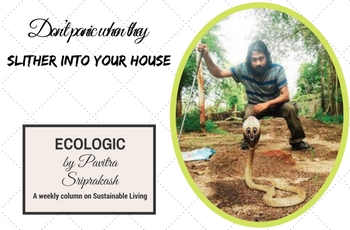26 Aug 2017, New Indian Express: ECOLOGIC- Pavitra Sriprakash, the Chief Designer and Director of Shilpa Architects writes about sustainable ways to handle man vs. wild encounters at your home.
Don’t panic when they slither into your house
The rains had stopped but the ground was still wet. A fully grown male cobra, perhaps 10 years old, lazily slithered over a pile of stones in my parent’s backyard in Chennai before sneaking into a defunct waterpipe. Hell immediately broke loose and a mission to kill was launched by the terrified maids and watchman.
The Spectacled Cobra (because of the spectacle like marking behind its head), or Indian Cobra, found all over the subcontinent is a member of the ‘big four’ species that inflict the most snake bites on humans. Luckily a phone call brought home in 15 minutes Shravan Krishnan, a wildlife enthusiast. “Keep your distance and do not lose sight,” Shravan warned before reaching.
Then, with precise movements the 6-foot long hooded specimen was picked in a flash and guided deftly into a bag. The cobra was released within a 3 km radius into the wild, and the next day the family held a quiet puja. All’s well that ends well!
However almost everyday there are heart rending media reports of wild gaurs falling into uncovered electric cable ditches, of elephant herds being rundown by trains or electrocuted by fences; of stray leopards stoned to death, of star tortoises being smuggled, of porcupines hunted for their quills or of migratory birds hunted to substitute for chicken in cheap roadside eateries. Whether we live in Kumaon at the edge of a forest or in urban surroundings: man vs wild conflicts happen repeatedly.
The WWF says, “people and animals are increasingly coming into conflict over living space and food. The animals, many of which are already threatened or endangered, are often killed in retaliation or to ‘prevent’ future conflicts.” Snakes are the same world over, in that they are looking for a steady supply of food and a safe place to hide.
There are a few things we could do to snake-proof any home. Removing weeds, piles of debris, firewood and unkempt vegetation eliminates places the top predators are likely to conceal themselves in. Mowing lawns regularly limit the populations of lizards, frogs and rats upon which snakes feed. Rocks and crevices heat up and provide warmth to the cold bodies of reptiles residing in them. Sealing such gaps in foundations eliminates secure shelters. In more rural settings, enclosures or fencing may be required to keep snakes out.
How do we peacefully coexist with serpents which are such a vital part of our ecosystem? The first is to not panic when we encounter them suddenly, then to assess the situation calmly before calling for help if they are venomous suspects. Relocation in a completely new environment can probably kill them because they won’t know where to hide, find prey and water.
A new territory can be home to another resident snake. A displaced snake will also have to re-adapt to survive the urban jungle. There are also a few species of plants to consider that are natural repellents as well. Deal with snakes at home humanely, and try to rescue or rehabilitate them. It is the sustainable and eco friendly way for them and us. Live and let live.
Link to the Article on the New Indian Express site
Download the PDF here



